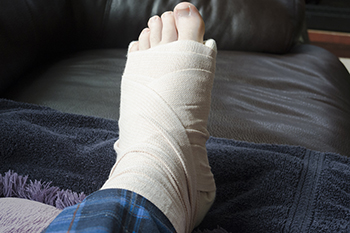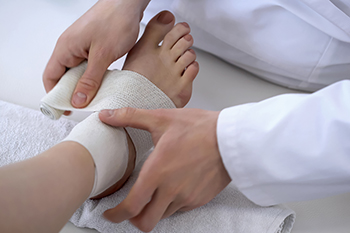Items filtered by date: January 2024
Managing an Achilles Tendon Injury

Achilles tendon injuries affect both seasoned athletes and occasional fitness enthusiasts alike. The Achilles tendon, the body's largest tendon, spans from the heel bone to the calf muscles. This strong tendon enables foot extension and toe pointing. Overuse, rapid escalation of physical activity, and inadequate pre-activity stretching can result in a painful inflammation known as Achilles tendonitis. As the activity continues, the injury may worsen and cause partial or total ruptures. Common in various sports such as running, gymnastics, and basketball, symptoms of Achilles tendon injuries include pain along the back of the foot and above the heel. This discomfort intensifies during ankle stretching or toe-standing. Diagnosis involves thorough physical examinations and additional tests such as musculoskeletal ultrasonography, MRI, and radiography. Treatment varies based on severity, ranging from rest, crutches, and cold compresses for mild cases to surgical intervention for severe ruptures. To navigate Achilles tendon injuries effectively, it is suggested that you schedule an appointment with a podiatrist for a full exam and a correct treatment plan.
Achilles tendon injuries need immediate attention to avoid future complications. If you have any concerns, contact Paul A. Santangelo, DPM of Illinois. Our doctor can provide the care you need to keep you pain-free and on your feet.
What Is the Achilles Tendon?
The Achilles tendon is a tendon that connects the lower leg muscles and calf to the heel of the foot. It is the strongest tendon in the human body and is essential for making movement possible. Because this tendon is such an integral part of the body, any injuries to it can create immense difficulties and should immediately be presented to a doctor.
What Are the Symptoms of an Achilles Tendon Injury?
There are various types of injuries that can affect the Achilles tendon. The two most common injuries are Achilles tendinitis and ruptures of the tendon.
Achilles Tendinitis Symptoms
- Inflammation
- Dull to severe pain
- Increased blood flow to the tendon
- Thickening of the tendon
Rupture Symptoms
- Extreme pain and swelling in the foot
- Total immobility
Treatment and Prevention
Achilles tendon injuries are diagnosed by a thorough physical evaluation, which can include an MRI. Treatment involves rest, physical therapy, and in some cases, surgery. However, various preventative measures can be taken to avoid these injuries, such as:
- Thorough stretching of the tendon before and after exercise
- Strengthening exercises like calf raises, squats, leg curls, leg extensions, leg raises, lunges, and leg presses
If you have any questions please feel free to contact our offices located in Niles and Rockford, IL . We offer the newest diagnostic tools and technology to treat your foot and ankle needs.
Diagnosing and Managing Foot Fractures

Foot fractures are common injuries that podiatrists frequently encounter, often involving the metatarsals and toes. Patients typically exhibit various symptoms, with pain and difficulty while walking being the most prevalent. Diagnosis relies on radiographic assessment or ultrasonography. The choice of management depends on the fracture's location and its impact on balance and weight-bearing. Treatment options may include splinting, avoiding weight-bearing activities, casts, boots, or orthotics. If you have sustained a foot fracture of any type, it is suggested that you schedule an appointment with a podiatrist for a proper evaluation and relief options
A broken foot requires immediate medical attention and treatment. If you need your feet checked, contact Paul A. Santangelo, DPM from Illinois. Our doctor can provide the care you need to keep you pain-free and on your feet.
Broken Foot Causes, Symptoms, and Treatment
A broken foot is caused by one of the bones in the foot typically breaking when bended, crushed, or stretched beyond its natural capabilities. Usually the location of the fracture indicates how the break occurred, whether it was through an object, fall, or any other type of injury.
Common Symptoms of Broken Feet:
- Bruising
- Pain
- Redness
- Swelling
- Blue in color
- Numbness
- Cold
- Misshapen
- Cuts
- Deformities
Those that suspect they have a broken foot shoot seek urgent medical attention where a medical professional could diagnose the severity.
Treatment for broken bones varies depending on the cause, severity and location. Some will require the use of splints, casts or crutches while others could even involve surgery to repair the broken bones. Personal care includes the use of ice and keeping the foot stabilized and elevated.
If you have any questions please feel free to contact our offices located in Niles and Rockford, IL . We offer the newest diagnostic and treatment technologies for all your foot and ankle needs.
Causes and Symptoms of Foot Discomfort During Pregnancy

Pregnancy brings about numerous changes in a woman's body, and foot discomfort often becomes a notable concern. One primary cause is the increased weight and pressure exerted on the feet due to the growing baby. This added stress can lead to swelling, commonly known as edema, making shoes feel tighter. Hormonal changes during pregnancy affect ligaments, potentially resulting in flat feet or overpronation, which can cause discomfort. Additionally, fluid retention can contribute to a feeling of heaviness and puffiness in the feet. As the pregnancy progresses, the body produces a hormone called relaxin, which loosens ligaments in preparation for childbirth, potentially impacting foot arches and stability. Common symptoms include swelling, aching, and changes in foot shape. Choosing supportive footwear, elevating the feet when possible, and staying physically active can help alleviate these discomforts and promote overall foot health during pregnancy. If you are experiencing foot pain during your pregnancy, it is strongly suggested that you seek the advice of a podiatrist who can guide you toward effective relief tips.
Pregnant women with swollen feet can be treated with a variety of different methods that are readily available. For more information about other cures for swollen feet during pregnancy, consult with Paul A. Santangelo, DPM from Illinois. Our doctor will attend to all of your foot and ankle needs.
What Foot Problems Can Arise During Pregnancy?
One problem that can occur is overpronation, which occurs when the arch of the foot flattens and tends to roll inward. This can cause pain and discomfort in your heels while you’re walking or even just standing up, trying to support your baby.
Another problem is edema, or swelling in the extremities. This often affects the feet during pregnancy but tends to occur in the later stages.
How Can I Keep My Feet Healthy During Pregnancy?
- Wearing orthotics can provide extra support for the feet and help distribute weight evenly
- Minimize the amount of time spent walking barefoot
- Wear shoes with good arch support
- Wear shoes that allow for good circulation to the feet
- Elevate feet if you experience swelling
- Massage your feet
- Get regular, light exercise, such as walking, to promote blood circulation to the feet
If you have any questions please feel free to contact our offices located in Niles and Rockford, IL . We offer the newest diagnostic and treatment technologies for all your foot and ankle needs.
Ankle Fracture Surgery as a Possible Relief Method

An ankle fracture can be a challenging ordeal, demanding careful consideration and, in some cases, surgical intervention. When a fracture is severe or involves multiple bone fragments, surgery becomes a viable option to restore stability and facilitate proper healing. The surgical procedure typically involves realigning the fractured bones and securing them with metal plates, screws, or rods. The goal is to reconstruct the anatomy of the ankle, allowing for optimal recovery and minimizing the risk of long-term complications. Post-surgery, patients enter a rehabilitation phase that involves a gradual return to weight-bearing activities and physical therapy to restore strength and flexibility. If you are considering ankle surgery, it is suggested that you consult a podiatrist who can determine if this is the correct choice for you.
Foot surgery is sometimes necessary to treat a foot ailment. To learn more, contact Paul A. Santangelo, DPM of Illinois. Our doctor will assist you with all of your foot and ankle needs.
When Is Surgery Necessary?
Foot and ankle surgery is generally reserved for cases in which less invasive, conservative procedures have failed to alleviate the problem. Some of the cases in which surgery may be necessary include:
- Removing foot deformities like bunions and bone spurs
- Severe arthritis that has caused bone issues
- Cosmetic reconstruction
What Types of Surgery Are There?
The type of surgery you receive will depend on the nature of the problem you have. Some of the possible surgeries include:
- Bunionectomy for painful bunions
- Surgical fusion for realignment of bones
- Neuropathy decompression surgery to treat nerve damage
Benefits of Surgery
Although surgery is usually a last resort, it can provide more complete pain relief compared to non-surgical methods and may allow you to finally resume full activity.
Surgical techniques have also become increasingly sophisticated. Techniques like endoscopic surgery allow for smaller incisions and faster recovery times.
If you have any questions please feel free to contact our offices located in Niles and Rockford, IL . We offer the newest diagnostic and treatment technologies for all your foot and ankle needs.
Wounds That Don't Heal Need to Be Checked
Definition and Causes of an Acute Ankle Sprain

An acute ankle sprain refers to a sudden and unexpected injury to the ligaments that support the ankle joint. These ligaments can become stretched or torn when the foot twists or turns beyond its normal range of motion. This injury often results from a misstep, an awkward landing, or a sudden change in direction, such as in sports activities. The causes of an acute ankle sprain are typically linked to excessive or forceful movements that strain the ankle ligaments. Common situations include stumbling on uneven ground, stepping off of a curb, or rolling the ankle during sports activities, such as basketball or soccer. Wearing high heels and poorly fitting footwear can also increase the risk of ankle sprains by destabilizing the ankle. Understanding the definition and causes of an acute ankle sprain is essential for both prevention and timely treatment. If you have sprained your ankle, it is strongly suggested that you consult a podiatrist who can accurately diagnose this condition, and offer treatment methods that are right for you.
Although ankle sprains are common, they aren’t always minor injuries. If you need your ankle injury looked at, contact Paul A. Santangelo, DPM from Illinois. Our doctor can provide the care you need to keep you pain-free and on your feet.
How Does an Ankle Sprain Occur?
Ankle sprains are the result of a tear in the ligaments within the ankle. These injuries may happen when you make a rapid shifting movement while your foot is planted. A less common way to sprain your ankle is when your ankle rolls inward while your foot turns outward.
What Are the Symptoms?
- Pain at the sight of the tear
- Bruising/Swelling
- Ankle area is tender to touch
- In severe cases, may hear/feel something tear
- Skin discoloration
Preventing a Sprain
- Wearing appropriate shoes for the occasion
- Stretching before exercises and sports
- Knowing your limits
Treatment of a Sprain
In many cases, the RICE method (Rest, Ice, Compression, and Elevate) is used to treat ankle sprains. However, you should see a podiatrist to see which treatment option would work best with your injury. In severe cases, surgery may be required.
It is important to ask your doctor about rehab options after you receive treatment for your injury. Stretching, strength training, and balance exercises may help the ankle heal while also preventing further injury.
If you have any questions, please feel free to contact our offices located in Niles and Rockford, IL . We offer the newest diagnostic and treatment technologies for all your foot care needs.

